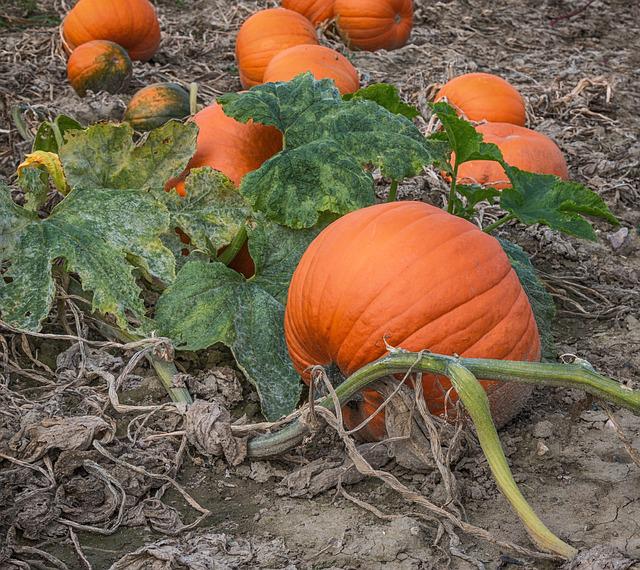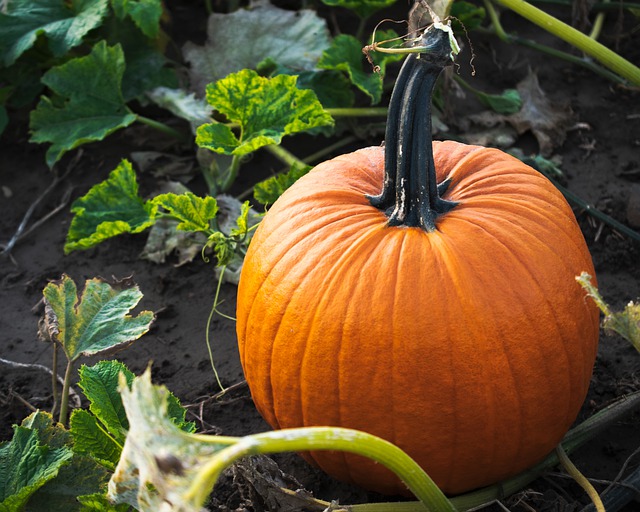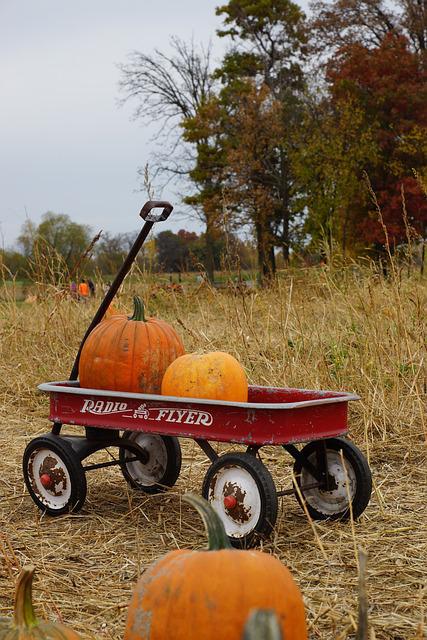Want to learn how to grow pumpkins? The secret is to begin planting sooner than you might think!
These fall staples are easy, inexpensive, and generally low on maintenance, thriving in almost all climates.
Native to North America, pumpkin (Cucurbita spp.) comes in various shades and sizes, including red, pink, white, blue, and the popular sizeable spherical orange, ribbed rind fruit type.
All pumpkins are edible, but the ornamentals are best for carving.
Like most squash, pumpkins are low-growing vining annuals with large coarse leaves, blooming in July and August with orange-to-yellow funnel-shaped flowers.
They’re warm-weather lovers, requiring quite an extended period of frost-free weather to mature.
The seeds usually germinate within ten days in warm soil temperatures of at least 600F. Therefore, plant as soon as the soil is warm enough in the spring.
Start the seeds indoors—two to four weeks before your area’s last spring frost—especially in areas without the essential long growing season.
There is a little more to just the temperature requirements, but before we explore it all, here are the answers to some of the commonly asked questions about how to grow pumpkins.
Frequently Asked Questions about How to Grow Pumpkins

Is pumpkin easy to grow?
Pumpkins are quite an easy crop as long as you shelter them from cold winds and offer adequate water and sunlight in the earliest days of the season. After the temperatures grow warmer, they will take off!
How long does it take to grow a pumpkin?
It depends on the variety, but generally, pumpkins take three to four months to mature—from planting time.
Can you grow pumpkins from a supermarket?
Yes, although most of the resulting plants might not be true-to-seed—fruiting a different variety—especially in the case of pumpkins grown from hybrid seeds.
On the other hand, Heirloom pumpkin seeds will produce similar fruits to the one purchased.
Can you plant pumpkin seeds straight from the pumpkin?
Once you get off the seeds from the fruit, spread them out on a dry paper towel and allow them to dry for a week.
You can sun-dry or simply put them in a cool, dry place. When completely dry, store the seeds in an envelope until you’re ready to plant.
Do pumpkins come back every year?
No. Pumpkins are annuals, so you’ll have to plant them fresh every growing season for maximum, fresh yield.
What is the secret to growing pumpkins?
The secret to pumpkin-growing lies in the timing!
Pumpkins enjoy long growing seasons with warm weather and soil conditions, so be sure to set them out when the conditions are right.
What is the best month to plant pumpkins?
Plant your pumpkins by late May if you reside in the Northern regions and for the Southern states by early July.
Can I grow pumpkin in winter?
Yes, you can grow pumpkins in winter if you live in a place with a warm climate.
However, note that pumpkins require a lot of sunlight to grow properly, so you may need to provide them with some artificial light if they don’t have access to direct sunlight.
How many pumpkin seeds should you plant?
Plant two to four pumpkin seeds per hill. If all seeds germinate, thin out the seedlings so that only two to three plants remain per hill.
How many pumpkins will grow on one plant?
Depending on the variety, a single pumpkin plant may produce two to five pumpkins.
Do pumpkins like shade or sun?
…Precisely, can pumpkins grow in the shade? Like all squash, bud, and fruit best in full sun, Pumpkins, with at least six hours of direct sunlight a day.
Though they’ll tolerate shade, the harvest may not be as much.
Do pumpkins need a lot of water? …And how often should pumpkins be watered?
Yes, pumpkins crave lots of water (one to two inches a week), considering they’re 80-90% water. To reduce the risk of disease, consider ground-level soaking or drip irrigation.
Can pumpkins grow in pots?
Yes, pumpkins will thrive in pots provided the soil is well-draining and large enough containers.
How do you grow pumpkins in pots?
Choose a considerably large pot (at least eighteen inches wide) with suitable drainage holes.
Fill the pot with quality potting soil. Select a dwarf or compact pumpkin variety, as full-size pumpkins need more room to spread out.
Water the pumpkin plants regularly, about one or two inches per week.
Offer the plants a balanced fertilizer feed every two weeks. Place the pot in an area that receives full sun for at least six hours per day.
Can pumpkins grow on a fence?
Yes. You can grow pumpkins on a fence by training the vines to grow along the fence line. Just ensure the fence is sturdy enough to support the weight of the pumpkins as they grow.
Can I grow pumpkins indoors?
It’s possible to grow pumpkins indoors but with a bit more effort. You’ll need to provide them with 18-24 hours of sunshine per day using grow lights.
Pumpkins also need warm temperatures, so you may have to use a heat lamp to keep the environment warm enough.
The pumpkins will also need to be pollinated by hand using a small paintbrush.
What can you not plant near a pumpkin?
Avoid growing pumpkins near large-root crops like beets, potatoes, and onions so they don’t rob your squash of nutrients. Plus, they may disturb the shallow pumpkin roots during harvest.
If planting in the same garden, be sure to leave plenty of space between the plants and consider choosing varieties that are smaller at maturity.
How to Grow Pumpkins in Your Backyard Garden
Once you decide on the pumpkin variety and the planting time, go ahead and prepare the growing site.
- Pie pumpkins are best for roasting and making pies. You want to try varieties like the Winter Luxury, New England Pie, or Baby Pam.
- Miniature Pumpkins—great for decorative purposes. Try Jack-Be-Littles; they’re tiny with a relaxing orange tone.
- Jack-O’Lantern pumpkins—They are less flavorful and larger than pies; they are best for carving. Try Rock Star, Howden, or Connecticut Field.
Preparing the pumpkin bed, planting, and care
- Pick a spot that receives full sun most of the day. The location should be open enough (preferably twenty to thirty feet) for the far-reaching pumpkin vines to spread freely.
- Till the soil tp four inches deep and work in organic compost to give the plants a boost of nutrients and also help improve the soil drainage.
Pumpkins love rich, moist, well-draining soil with pH levels of 6.0-6.8. Consider a soil test and amend with lime, compost, or bone meal.
- Build a small mound(s), depending on the number of pumpkin plants you would like to grow.
Building mounds for starting pumpkin seeds
Mounds help warm up the soil, reduce pests, and improve drainage.
- In the mound center, sow three pumpkin seeds (approximately 3 inches deep), then pat the soil over the seeds. Water thoroughly after planting.
- Ensure a spacing of at least 1.2-2.4 meters if growing two or more pumpkin plants. 0.9 m (3 feet) is okay for the mini varieties.
You may want to consider sowing in a trench to help enhance the plants’ establishment process, primarily if you reside in an area with strong winds.
- For transplants, space five feet apart; for easier sprawling and optimum yield.
- Note that adequate spacing helps optimize the fruit size and not the number of fruits produced per plant.
Watering pumpkin plants
Water regularly, preferably in the morning, to keep the soil moist (not soggy).
Reduce your watering frequency once the pumpkins begin to turn orange, and then cut the watering entirely about a week before the estimated maturity time.
- Right after the seedlings sprout, fertilize by spreading compost around their (seedlings’) base areas—to help encourage healthy growth.
- Thin as needed, leaving the most robust plants.
- Clip off the vines’ tips once they’re about five feet, so more side shoots can grow, which helps boost pumpkin production.
Pumpkins, in most cases, are bothered by pests like the four-line beetles, striped and spotted cucumber beetles, squash bugs, and aphids.
Hand-pick or spray them off with a stream of plain or soapy water; or ammonia-water solution.
Harvesting Pumpkins
A uniformly bright orange color (except for the mottled or white variety), tough skin, and shriveling vines are signs of a ready-to-harvest pumpkin.
Using shears, cut the stem, leaving a few inches at the top of the pumpkin fruits—to help prevent them from going bad too quickly.
Store them in a cool, dry place and enjoy them throughout the winter season!
The Takeaway on Learning How to Grow Pumpkins
‘How to grow pumpkins’ is a thought most gardeners hold in their minds, delaying the action and missing the joyous pumpkin harvest.
By following the tips in this article, you can grow pumpkins successfully and have them as part of your autumn decorations and use them in pies and other delicacies.
If you’re to forget everything, just remember these two vital pumpkin-growing requirements: Adequate space (ideally, 93 square meters per plant) and a long growing season (seventy-five to a hundred twenty frost-free days).
…And that’s how to grow pumpkins!



